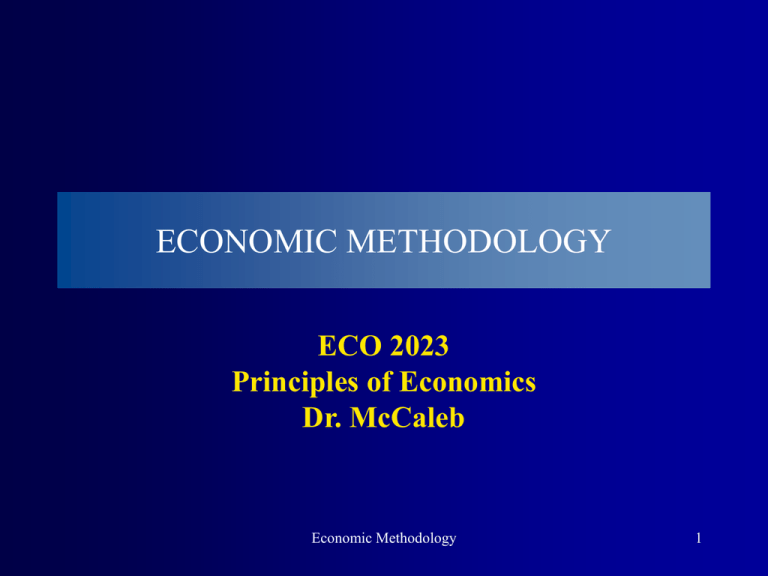
ECONOMIC METHODOLOGY
ECO 2023
Principles of Economics
Dr. McCaleb
Economic Methodology
1
TOPIC OUTLINE
I.
Ceteris Paribus
II. Correlation Does Not Imply Causation
Economic Methodology
2
Ceteris Paribus
Economic Methodology
3
CETERIS PARIBUS
Ceteris Paribus
Conclusions about the effect of a variable require
other things unchanged
To determine the effect of a change in one variable on another
variable requires that other things remain constant. Ceteris paribus
means “other things remaining constant”.
Laboratory experiments allow scientists to hold other things constant
and focus on the effects of a single variable. Statistical techniques
allow economists to do the same thing.
Economic Methodology
4
CETERIS PARIBUS
Ceteris Paribus
Example
The law of demand states that the quantity demanded any good
decreases whenever the price of the good increases.
But then you observe that consumption of steak has decreased in
recent years even though the price of steak also decreased.
Does this mean the law of demand is invalid? Explain.
Economic Methodology
5
Correlation Does Not Imply Causation
Economic Methodology
6
Economic Methodology
7
Sexual Lyrics Prompt Teens to Have Sex
By LINDSEY TANNER, AP Medical
Writer
CHICAGO - Teens whose iPods are full of
music with raunchy, sexual lyrics start having
sex sooner than those who prefer other songs,
a study found.
Economic Methodology
8
CORRELATION DOES NOT IMPLY
CAUSATION
Cause and Effect Relationships
Methodological fallacy: Correlation does not imply
causation
Correlation is the tendency for the values of two variables to move
in a predictable and related way.
Because two variables appear to be correlated does not mean that
movements of the first variable cause movements of the second
variable.
Economic Methodology
9
CORRELATION DOES NOT IMPLY
CAUSATION
Cause and Effect Relationships
There are four possible explanations for any observed
correlation.
•
•
•
•
Cause and effect
Reverse causation
Omitted variables
Spurious correlation
Economic Methodology
10
CORRELATION DOES NOT IMPLY
CAUSATION
Cause and Effect Relationships
Example
We observe that cities with more police have higher crime rates. Can
we validly conclude that having more police causes a city to also
have more crime?
No. Consider the following possibilities.
Economic Methodology
11
CORRELATION DOES NOT IMPLY
CAUSATION
Cause and Effect Relationships
Cause and effect: More police cause higher crime rates
The more police a city has, the more crimes get detected and
reported. Therefore, a city’s reported crime rate is higher if it has
more police because more of the crimes are detected and reported.
Note that the true crime rate for a city with more police may not be
any higher than for a city with fewer police, but more of the crimes
are detected and reported. More police cause better detection and
reporting of crimes.
Economic Methodology
12
CORRELATION DOES NOT IMPLY
CAUSATION
Cause and Effect Relationships
Reverse causation: More crimes cause cities to hire
more police
The correlation does indeed imply a cause and effect relationship,
but it is the opposite of what it appears. It isn’t that more police
cause more crimes. Instead, more crimes cause cities to hire more
police.
Economic Methodology
13
CORRELATION DOES NOT IMPLY
CAUSATION
Cause and Effect Relationships
Omitted variables: Larger cities have both more police
and higher crime rates
There is no cause and effect relationship between police and crime
rates. More police don’t cause more crimes and more crimes don’t
result in more police.
Instead, a third variable, the size of the city, is the cause and both the
number of police and the number of crimes are the results. Police
and crimes are correlated only because they are both results of a
third omitted variable, city size.
Economic Methodology
14
CORRELATION DOES NOT IMPLY
CAUSATION
Cause and Effect Relationships
Spurious correlation: Police and crime are unrelated
There is no cause and effect relationship between police and crime
rates. More police don’t cause more crimes and more crimes don’t
result in more police. Nor are they both the result of an omitted
variable.
The apparent correlation between police and crime is a coincidence.
Perhaps the sample of cities is biased. It is too small or it isn’t truly
representative. With a larger or more representative sample, the
correlation would disappear.
Economic Methodology
15








